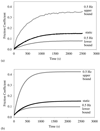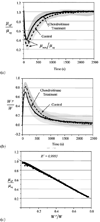The role of interstitial fluid pressurization in articular cartilage lubrication
- PMID: 19464689
- PMCID: PMC2758165
- DOI: 10.1016/j.jbiomech.2009.04.040
The role of interstitial fluid pressurization in articular cartilage lubrication
Abstract
Over the last two decades, considerable progress has been reported in the field of cartilage mechanics that impacts our understanding of the role of interstitial fluid pressurization on cartilage lubrication. Theoretical and experimental studies have demonstrated that the interstitial fluid of cartilage pressurizes considerably under loading, potentially supporting most of the applied load under various transient or steady-state conditions. The fraction of the total load supported by fluid pressurization has been called the fluid load support. Experimental studies have demonstrated that the friction coefficient of cartilage correlates negatively with this variable, achieving remarkably low values when the fluid load support is greatest. A theoretical framework that embodies this relationship has been validated against experiments, predicting and explaining various outcomes, and demonstrating that a low friction coefficient can be maintained for prolonged loading durations under normal physiological function. This paper reviews salient aspects of this topic, as well as its implications for improving our understanding of boundary lubrication by molecular species in synovial fluid and the cartilage superficial zone. Effects of cartilage degeneration on its frictional response are also reviewed.
Figures








References
-
- Ahmed AM, Burke DL. In-vitro measurement of static pressure distribution in synovial joints--Part I: Tibial surface of the knee. J Biomech Eng. 1983;105:216–225. - PubMed
-
- Ahmed AM, Burke DL, Yu A. In-vitro measurement of static pressure distribution in synovial joints--Part II: Retropatellar surface. J Biomech Eng. 1983;105:226–236. - PubMed
-
- Almeida ES, Spilker RL. Mixed and Penalty Finite Element Models for the Nonlinear Behavior of Biphasic Soft Tissues in Finite Deformation: Part I - Alternate Formulations. Comput Methods Biomech Biomed Engin. 1997;1:25–46. - PubMed
-
- Armstrong CG, Lai WM, Mow VC. An analysis of the unconfined compression of articular cartilage. J Biomech Eng. 1984;106:165–173. - PubMed
-
- Ateshian GA. A theoretical formulation for boundary friction in articular cartilage. J Biomech Eng. 1997;119:81–86. - PubMed
Publication types
MeSH terms
Substances
Grants and funding
LinkOut - more resources
Full Text Sources
Other Literature Sources

